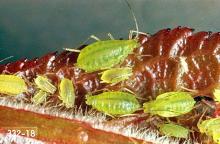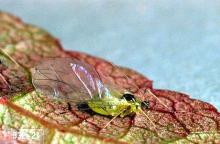Hop aphid (Phorodon humuli)
Leaf curl plum aphid (Brachycaudus helichrysi)
Thistle aphid (Brachycaudus cardui)
Pest description and crop damage Several aphid species attack plums and prunes, including the hop aphid, leafcurl plum aphid, and thistle aphid. The hop aphid adult can be pale yellowish green wingless form or dark green, nearly black winged form. The leafcurl plum aphid varies considerably in color from shiny green to brownish-green or brownish yellow. The thistle aphid is relatively large (approx. 0.1 inch in length), shiny green with dark patches on its back. Initially, aphids feed on the shoot tips, which on young trees can cause stunting and malformation of the shoot tips. On older trees, fruit set is reduced in subsequent years if aphid populations are high. Aphids also produce a sticky honeydew that promotes sooty mold growth on fruit.
Biology and life history Aphids have complicated lifecycles that include multiple host plants, reproductive strategies, and adult forms. The hop aphid overwinters as eggs in crevices and twigs on Prunus trees, the primary hosts. Plum/prune trees are the preferred overwintering hosts, but peaches and cherries are also used. The eggs hatch in late March, and several generations of wingless females feed and reproduce on the plum/prune trees before the winged females migrate to the secondary host-hops-in May. Several generations of wingless females are on the hops as late as August and September. Then winged adults fly back to the Prunus hosts and, after mating, lay the overwintering eggs around buds, bud scales, or cracks in the bark of twigs and shoots. The life cycles of the other two aphids are roughly similar. Many secondary summer hosts of the leafcurl plum aphid and the thistle aphid are plants in the family Asteraceae, which include chrysanthemum, mayweed, and groundsel.
Pest monitoring Begin observing shoots prior to budbreak, as management is most effective early in the season while aphid abundance is still low and before the emerging leaves begin to curl about and protect aphid colonies.
Management-biological control
Aphids have many natural enemies, which include lady beetle, syrphid fly larvae, minute pirate bug, big-eyed bug, damsel bug, lacewing larvae, and numerous wasp parasitoids. Avoid broad-spectrum insecticide applications that disrupt the life cycles of these natural enemies.
Management-cultural control
Home orchardists: Wash aphids from plants with a strong stream of water or by hand wiping. Aphid populations tend to be attracted to fruit trees overly fertilized with nitrogen. Avoid excessive watering which, together with nitrogen applications, produces flushes of succulent growth.
Management-chemical control: HOME USE
Dormant-season spray
Apply only during dormant or delayed-dormant period. Apply with enough water to cover the entire tree thoroughly.
- horticultural mineral oil-Some formulations are OMRI-listed for organic use.
Growing-season spray
Apply according to label specifications, when overwintering eggs hatch during prebloom or petal fall. Summer applications should be before leaves curl.
- azadirachtin (neem extract)-Some formulations are OMRI-listed for organic use.
- carbaryl-Highly toxic to bees.
- gamma-cyhalothrin-Highly toxic to bees.
- horticultural mineral oil-Some formulations OMRI-listed for organic use.
- imidacloprid-Highly toxic to bees. Soil drenches may have residual activity in woody plants lasting for 12 or more months. If short-term management is the goal, consider other approaches.
- insecticidal soap-May require several applications. Some formulations are OMRI-listed for organic use.
- kaolin-Applied as a spray to leaves, stems, and fruit, it acts as a repellant to some insect pests. Some formulations are OMRI-listed for organic use.
- lambda-cyhalothrin-Highly toxic to bees.
- plant-derived essential oils-Some have shown efficacy against aphids. Some formulations are OMRI-listed for organic use.
- pyrethrins (often as a mix with other ingredients)-Highly toxic to bees. Some formulations are OMRI-listed for organic use.
- zeta-cypermethrin-Highly toxic to bees.
Management-chemical control: COMMERCIAL USE
Apply when aphid eggs hatch during pre-bloom or petal fall. In summer, apply before leaves curl for best control. Fall sprays can provide excellent aphid control for the next growing season.
Dormant and delayed-dormant spray
- horticultural mineral oil (rates vary; check product label)-Use oil sprays during dormant or delayed-dormant period. REI varies, check product label. Some formulations are OMRI-listed for organic use.
Prebloom spray
- diazinon (Diazinon 50W) at 1 lb/100 gal water (4 lb/A). REI 4 days. Apply as a dormant spray. When using spray oils, follow spray oil manufacturer's use directions. Do not apply more than 4 lb product or 6 gal oil per acre. If applied in late April or May, mix diazinon with 1 gal light to medium summer horticultural oil per 100 gal water. Do not exceed one in-season foliar application per growing season.
Spring and summer spray
- acetamiprid (Assail 30SG) at 2.5 to 5.3 oz/A. REI 12 hr. PHI 7 days.
- imidacloprid (Prey 1.6F, Nuprid 1.6F) at 2 fl oz/100 gal water (4 to 8 fl oz/A). REI 12 hr. PHI 7 days. Warning: Toxic to bees. Do not use until pollination is complete and bees have left the orchard.
- spirotetramat (Movento, Ultor)-Product formulations vary, check label for rates. REI 24 hr. PHI 7 days.
- thiamethoxam/chlorantraniliprole (Voliam Flexi) at 4 to 6 oz/A. Do not apply exceed 14 oz/A or 0.172 lb/A of Voliam Flexi per season. REI 12 hr. PHI 14 days.
Postharvest spray
- diazinon (Diazinon 50W) at 1 lb/100 gal water (4 lb/A). Apply as a dormant spray. When using spray oils, follow spray oil manufacturer's use directions. Do not apply more than 4 lb product or 6 gal oil per acre. If applied in late April or May, mix diazinon with 1 gal of light to medium summer horticultural oil per 100 gal water. REI 4 days. PHI 21 days. Do not exceed one in-season foliar application per growing season.


